Glendale, California 作者: 来源: 发布时间:2021-07-19
I.Population and Area
₋Area
Land: 30.60 sq mi (79.25 km2)
₋Population
Total: 191,719
Density: 6,540.96/sq mi (2,525.47/km2)
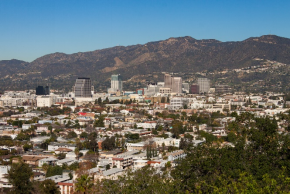
II.Natural Geography
₋Glendale /ˈɡlɛndeɪl/ is a city in Los Angeles County, California, United States. As of the 2010 census it had a population of 191,719, and in 2019 the population was e stimated at 199,303, making it the fourth-largest city in Los Angeles County and the 23rd-largest city in California. It is located about 10 miles (16 km) north of downtown Los Angeles.
₋Glendale lies in the southeastern end of the San Fernando Valley, bisected by the Verdugo Mountains, and is a suburb in the Los Angeles metropolitan area. The city is bordered to the northwest by the Sun Valley and Tujunga neighborhoods of Los Angeles; to the northeast by La Cañada Flintridge and the unincorporated area of La Crescenta; to the west by Burbank and Griffith Park; to the east by Eagle Rock and Pasadena; to the south by the Atwater Village neighborhood of Los Angeles; and to the southeast by Glassell Park neighborhood of Los Angeles. The Golden State, Ventura, Glendale, and Foothill freeways run through the city.
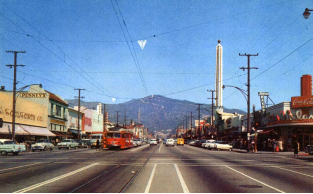
III.GDP
₋The average salary in Glendale, CA is $74k. Trends in wages increased by 0.9 percent in Q1 2020. The cost of living in Glendale, CA is 57 percent higher than the national average. The most popular occupations in Glendale, CA are Software Engineer, Project Manager, (Unspecified Type / General), and Executive Assistant which pay between $44k and $133k per year. The most popular employers in Glendale, CA are The Walt Disney Company, Age of Learning Inc., and Walt Disney Imagineering.
₋Website: https://www.payscale.com/research/US/Location=Glendale-CA/Salary
IV.Industrial Characteristics
₋Grand Central Airport was a municipal airport developed from 1923 which became the largest employer in Glendale for many years, and contributed to the development of aviation in the United States in many important ways. The main terminal building still stands and includes both Art Deco and Spanish-style architectural elements. The facility was the first official terminal for the Los Angeles area, as well as the departure point for the first commercial west-to-east transcontinental flight flown by Charles Lindbergh. During World War II, the Grand Central Air Terminal building was camouflaged to protect it from enemy targeting. It was closed down in 1959, and made way for the Grand Central Business Centre, an industrial park.
₋Forest Lawn Memorial Park started in Tropico (later annexed to Glendale) in 1906 and is famous for its art collection and the burial of many celebrities, as well as for the 1933 opening of the first funeral home on cemetery grounds anywhere in the United States. The Bob's Big Boy chain of hamburger restaurants started in Glendale on East Colorado in August 1936, and the Baskin-Robbins "31 Flavors" chain of ice cream parlors started in Adams Square in 1945. The Glendale Public Library on Harvard Street houses its "Special Collections" department which contains original documents and records on much of the history of Glendale. It also contains one of the largest collections of books on cats in the world, over 20,000 volumes. It was donated to the library in the 1950s by the Jewel City Cat Fanciers Club.[citation needed]
₋The city experienced significant development in the 1970s, with the completion of the Glendale Freeway (Highway 2) and the Ventura Freeway (Highway 134). This included redevelopment of Brand Boulevard, renovation of the 1925 Alex Theatre, and construction of the Glendale Galleria shopping mall which opened in 1976, and was further expanded in 1982.
₋Several large companies have offices in Glendale including the U.S. headquarters of International House of Pancakes. The Los Angeles regional office of California's State Compensation Insurance Fund is in Glendale. Americas United Bank was founded in Glendale in 2006 and is still headquartered there. In August 2013, Avery Dennison Corp., a label maker for major brands, announced plans to move its headquarters from Pasadena to Glendale. Avery employs about 26,000 people. The U.S. headquarters of the Swiss foods multinational Nestlé plans to move out by 2018.
₋Glendale, along with Burbank, has served as a major production center for the U.S. entertainment industry and the U.S. animation industry in particular for several decades, because the Walt Disney Company outgrew its Burbank studio lot in the early 1960s, and started expanding into the closest business park available, which happened to be Glendale's Grand Central Business Centre about two miles east. First came the headquarters for Imagineering, followed in the 1980s by other divisions and offices. Today, Disney's Grand Central Creative Campus (known as GC3 for short) is home to Consumer Products, Disney Interactive, the Muppets Studio, and Marvel Animation Studios From 1985 to 1995, Walt Disney Animation Studios (then known as Walt Disney Feature Animation) was headquartered in the Grand Central Business Centre, meaning that most of the films of the Disney Renaissance era were actually developed in Glendale. DisneyToon Studios, a division of WDAS, is still located in the Grand Central Business Centre near GC3, along with the Animation Research Library, Disney Animation's archive. Disney-owned KABC-TV is located on Circle 7 Drive to the south of GC3.
₋In 1994, Steven Spielberg, Jeffrey Katzenberg, and David Geffen formed DreamWorks SKG, a diversified entertainment company. DreamWorks Animation remains located in the city's Grand Central Business Centre on land formerly occupied by a helicopter landing base next to the old airfield (and next to KABC-TV). Thus, many American animators who worked on feature films in the 1990s and 2000s have spent large portions of their careers in Glendale working for Disney or DreamWorks.
₋In 2005, construction began near the Galleria of developer Rick Caruso's "Americana at Brand", a 15.5-acre (63,000 m2) outdoor shopping and residential community. Caruso had previously designed and built the Grove at Farmers Market. The new Glendale development was opened to the public on May 2, 2008, and features 75 shops and restaurants, 238 apartments, 100 condominiums, and a Pacific Theatres 18-plex Cinema which seats 3000 people.
V.Attractions
1.Universal Studios Hollywood
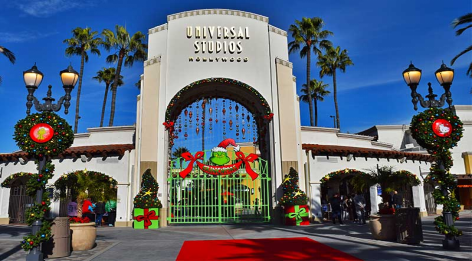
₋Universal Studios Hollywood i s a film studio and theme park in the San Fernando Valley area of Los Angeles County, California. About 70% of the studio lies within the unincorporated county island known as Universal City while the rest lies within the city limits of Los Angeles, California. It is one of the oldest and most famous Hollywood film studios still in use. Its official marketing headline is "The Entertainment Capital of LA". It was initially created to offer tours of the real Universal Studios sets and is the first of many full-fledged Universal Studios Theme Parks located across the world.
₋Outside the theme park, a new, all-digital facility near the Universal Pictures backlot was built in an effort to merge all of NBCUniversal's West Coast operations into one area. As a result, the current home for KNBC, KVEA and NBC News with Telemundo Los Angeles Bureaus with new digital facility is on the Universal lot formerly occupied by Technicolor SA. Universal City includes hotels Universal Hilton & Towers, the Sheraton Universal Hotel, and Universal CityWalk, which offers a collection of shops, restaurants, an 18-screen Universal Cinema and a seven-story IMAX theater. In 2017, the park hosted 9.056 million guests, ranking it 15th in the world and 9th among North American parks.
₋Address: 100 Universal City Plaza, Universal City, CA 91608, United States
₋Opened: July 15, 1964
₋Phone: +1 800-864-8377
₋Website: https://www.universalstudioshollywood.com/
2.Dodger Stadium
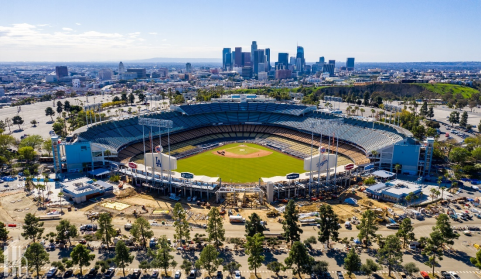
₋Dodger Stadium is a baseball park in the Elysian Park neighborhood of Los Angeles, California. It is the home stadium of Major League Baseball's Los Angeles Dodgers. Opened 58 years ago on April 10, 1962, it was constructed in less than three years at a cost of US$23 million. It is the oldest ballpark in MLB west of the Mississippi River, and third-oldest overall, after Fenway Park in Boston (1912) and Wrigley Field in Chicago (1914), and is the world's largest baseball stadium by seat capacity. Often referred to as a "pitcher's ballpark", the stadium has seen 12 no-hitters, two of which were perfect games.
₋The stadium hosted the Major League Baseball All-Star Game in 1980—and will host in 2022—as well as games of 10 World Series (1963, 1965, 1966, 1974, 1977, 1978, 1981, 1988, 2017, and 2018). It also hosted the semifinals and finals of the 2009 and 2017 World Baseball Classics as well as exhibition baseball during the 1984 Summer Olympics. It will also host baseball and softball during the 2028 Summer Olympics. The stadium hosted a soccer tournament on August 3, 2013 featuring four clubs, the hometown team Los Angeles Galaxy, and Europe's Real Madrid, Everton, and Juventus. The Los Angeles Kings and Anaheim Ducks played a regular season game in 2014 as part of the NHL Stadium Series.
₋In the mid-1950s, Brooklyn Dodgers team president Walter O'Malley had tried to build a domed stadium in the New York City borough of Brooklyn, but was unable to reach an agreement with city officials for the land acquisition, and eventually reached a deal with the city of Los Angeles. The land for Dodger Stadium had been seized from local owners and inhabitants in the early 1950s by the city of Los Angeles, using eminent domain with funds from the federal Housing Act of 1949. The city had planned to develop the Elysian Park Heights public housing project, which included two dozen 13-story buildings and more than 160 two-story townhouses, in addition to newly rebuilt playgrounds and schools, and a college.
₋Before construction could begin on the housing project, the local political climate changed greatly when Norris Poulson was elected mayor of Los Angeles in 1953. Proposed public housing projects such as Elysian Park Heights lost most of their support as they became associated with socialist ideals. Following protracted negotiations, the city purchased the Chavez Ravine property back from the Federal Housing Authority at a drastically reduced price, with the stipulation that the land be used for a public purpose. It was not until June 3, 1958, when Los Angeles voters approved a "Taxpayers Committee for Yes on Baseball" referendum, that the Dodgers were able to acquire 352 acres (1.42 km2) of Chavez Ravine from the city. While Dodger Stadium was under construction, the Dodgers played in the league's largest capacity venue from 1958 through 1961 at their temporary home, the Los Angeles Memorial Coliseum, which could seat in excess of 90,000 people.
₋Los Angeles–based Mike Davis, in his seminal work on the city, City of Quartz, describes the process of gradually convincing Chavez Ravine homeowners to sell. With nearly all of the original Spanish-speaking homeowners initially unwilling to sell, developers resorted to offering immediate cash payments, distributed through their Spanish-speaking agents. Once the first sales had been completed, remaining homeowners were offered increasingly lesser amounts of money, to create a community panic of not receiving fair compensation, or of being left as one of the few holdouts. Many residents continued to hold out despite the pressure being placed upon them by developers, resulting in the Battle of Chavez Ravine, a ten-year struggle by the residents to maintain control of their property, which they ultimately lost.
₋Dodger Stadium was the first Major League Baseball stadium since the initial construction of the original Yankee Stadium to be built using 100% private financing, and the last until Oracle Park in San Francisco opened in 2000. Ground was broken for Dodger Stadium on September 17, 1959. The top of local ridges were removed and the soil was used to fill in Sulfur and Cemetery Ravines to provide a level surface for a parking lot and the stadium. A local elementary school (Palo Verde) was simply buried and sits beneath the parking lot northwest of third base. A total of 8 million cubic yards (6,100,000 m3) of earth were moved in the process of building the stadium. A total of 21,000 precast concrete units, some weighing as much as 32 tons, were fabricated onsite and lowered into place with a specially built crane to form the stadium's structural framework. The stadium was originally designed to be expandable to 85,000 seats by expanding the upper decks over the outfield pavilions; the Dodgers have never pursued such a project.
₋Dodger Stadium was also the home of the Los Angeles Angels from 1962 through 1965. To avoid constantly referring to their landlords, the Angels called the park Chavez Ravine Stadium (or just "Chavez Ravine"), after the geographic feature in which the stadium sits.
₋Address: 1000 Vin Scully Ave, Los Angeles, CA 90012, United States
₋Capacity: 56,000
₋Phone: +1 866-363-4377
₋Website: https://www.mlb.com/dodgers/ballpark
3.Autry Museum of the American West
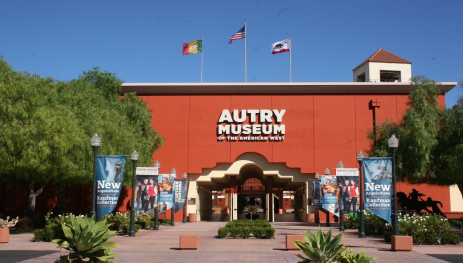
₋The Autry Museum of the American West is a museum in Los Angeles, California, dedicated to exploring an inclusive history of the American West. Founded in 1988, the museum presents a wide range of exhibitions and public programs, including lectures, film, theater, festivals, family events, and music, and performs scholarship, research, and educational outreach. It has two sites and attracts about 150,000 visitors annually.
₋In 2013, it extensively redesigned and renovated the Irene Helen Jones Parks Gallery of Art and the Gamble Firearms Gallery in its main building. In its related opening exhibit for the Parks Gallery, Art of the West, the new organization enabled material to be presented in relation to themes rather than chronology, and paintings were shown next to crafts, photography, video and other elements in new relationships.
₋Address: Griffith Park, 4700 Western Heritage Way, Los Angeles, CA 90027, United States
₋Phone: +1 323-667-2000
₋Website: https://theautry.org/
VI.History
₋Origins
₋The area was long inhabited by the Tongva people (or "People of the Earth"), who were later renamed the Gabrieleños by the Spanish missionaries, after the nearby Mission San Gabriel Arcángel.
₋In 1798, José María Verdugo, a corporal in the Spanish army from Baja California, received the Rancho San Rafael from Governor Diego de Borica, formalizing his possession and use of land on which he had been grazing livestock and farming since 1784. Rancho San Rafael was a Spanish concession, of which 25 were made in California. Unlike the later Mexican land grants, the concessions were similar to grazing permits, with the title remaining with the Spanish crown.
₋In 1860, his grandson Teodoro Verdugo built the Catalina Verdugo Adobe, which is the oldest building in Glendale. The property is the location of the Oak of Peace, where early Californio leaders including Pio Pico met in 1847 and decided to surrender to Lieutenant Colonel John C. Frémont.
₋Verdugo's descendants sold the ranch in various parcels, some of which are included in present-day Atwater Village, Eagle Rock, and Highland Park neighborhoods of Los Angeles.
₋In 1884, residents gathered to form a townsite and chose the name "Glendale" (it was bounded by First Street (now Lexington Drive) on the north, Fifth Street (now Harvard Street) on the south, Central Avenue on the west, and the Childs Tract on the east. Residents to the southwest formed "Tropico" in 1887.
₋The Pacific Electric Railway brought streetcar service in 1904.
₋Post incorporation
₋Glendale incorporated in 1906, and annexed Tropico 12 years later. An important civic booster of the era was Leslie Coombs Brand (1859–1925), who built an estate in 1904 called El Miradero, featuring an eye-catching mansion, the architecture of which combined characteristics of Spanish, Moorish, and Indian styles, copied from the East Indian Pavilion at the 1893 World's Columbian Exposition held in Chicago, which he visited. Brand loved to fly, and built a private airstrip in 1919 and hosted "fly-in" parties, providing a direct link to the soon-to-be-built nearby Grand Central Airport. The grounds of El Miradero are now city-owned Brand Park and the mansion is the Brand Library, according to the terms of his will. Brand partnered with Henry E. Huntington to bring the Pacific Electric Railway, or the "Red Cars", to the area. Today, he is memorialized by one of the city's main thoroughfares, Brand Boulevard.
₋The city's population rose from 13,756 in 1920 to 62,736 in 1930. The Forest Lawn Cemetery opened in 1906 and was renamed Forest Lawn Memorial-Park in 1917. Pioneering endocrinologist and entrepreneur Henry R. Harrower opened his clinic in Glendale in 1920, which for many years was the largest business in the city. The American Green Cross, an early conservation and tree preservation society, was formed in 1926 (it disbanded three years later and the current organization of that name is unrelated).
₋Grand Central Airport was the departure point for the first commercial west-to-east transcontinental flight flown by Charles Lindbergh.
₋Until as late as the 1960s, Glendale was a sundown town. Nonwhites were required to leave city limits by a certain time each day or risk arrest and possible violence. In the 1930s, Glendale and Burbank prevented the Civilian Conservation Corps from stationing African American workers in a local park, citing sundown town ordinances that both cities had adopted. In 1964, Glendale was selected by George Lincoln Rockwell to be the West Coast headquarters of the American Nazi Party. Its offices, on Colorado Street in the downtown section of the city, remained open until the early 1980s.
₋Historic architecture
₋Main article: Glendale Register of Historic Resources and Historic Districts
₋Glendale began its historic preservation program in 1977 with the designation of 28 properties as city landmarks. In 1997, the program evolved with the establishment of the Glendale Register of Historic Resources. The register now has over 100 properties. In addition, 11 properties in Glendale are listed on the National Register of Historic Places. The city's most honored historic properties include the Catalina Verdugo Adobe, Brand Library & Art Center, Glendale Southern Pacific Railroad Depot, Grand Central Air Terminal, and Alex Theatre.
VII.Other Information
₋Transportation
₋LADOT, Metro Local, Metro Rapid, and Glendale Beeline all have buses that run in the city. Glendale Transportation Center provides connections to Greyhound buses and three train lines. Glendale is served by four freeways: the Glendale Freeway (State Route 2), the Ventura Freeway (State Route 134), the Foothill Freeway (Interstate 210) and the Golden State Freeway (Interstate 5).
₋Law enforcement
₋Glendale maintains its own police department (GPD), which operates from a main station in downtown Glendale, a downtown substation in the Glendale Galleria, and the Montrose substation in Verdugo City. Glendale Community College also operates its own police department (GCCPD). The California Highway Patrol has its Southern Division Headquarters on Central Avenue in downtown Glendale.
₋Fire department
₋Fire protection is provided by the Glendale Fire Department (GFD). The GFD is an all-risk, career fire protection agency, responding to about 17,000 emergency and nonemergency calls for service annually. The GFD consists of nine strategically located fire stations, with mutual aid provided by the Los Angeles County Fire Department, Los Angeles City Fire Department, Burbank Fire Department, and Pasadena Fire Department. The department maintains a "Class 1" ISO rating as part of certification through the Public Protection Classification Program.
₋Verdugo Fire Communications Center
₋The Verdugo FCC was established on August 1, 1979, between the cities of Burbank, Glendale, and Pasadena as a way to consolidate fire dispatching and telecommunications between the departments. Presently, Verdugo provides services to all 13 fire departments in the California OES "Area C" mutual aid plan, making them a regional dispatch center.
₋The center is stationed on the third floor of Glendale Fire Department's headquarters (Fire Station 21) and handles roughly 72,000 calls for service annually. The fire chiefs from Burbank, Glendale and Pasadena oversee the center under a joint powers authority. These cities contract services from the center: Bob Hope Airport, Warner Brothers, Disney Studios, South Pasadena, San Marino, San Gabriel, Arcadia, Monrovia, Sierra Madre, Montebello, Alhambra, Vernon, and Monterey Park.
VIII.Contact Information
₋Government
Type: Council-Manager
Mayor: Vrej Agajanian
₋City Hall
₋Address:
613 E. Broadway
Glendale, CA 91206-4391
₋TEL: (818) 548-4844
₋Website: https://www.glendaleca.gov/government/departments/management-services/contact-city-officials-directly
